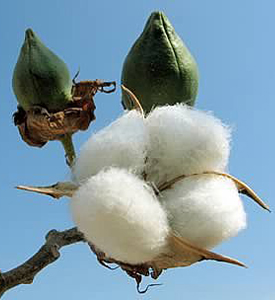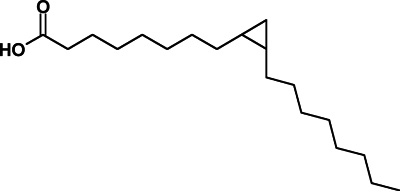
The cyclopropane synthase found in cotton and other plants adds a methyl group across the double bond of 18:1 to synthesize cyclopropane FA. Cyclopropane fatty acids are prized for oxidative stability while retaining low viscosity. They therefore have wide applications as lubricants and potentially in biodiesel
A wide array of unusual fatty acids is found in seed oils. Among these are fatty acids containing three-member carbocyclic rings, namely cis-cyclopropane fatty acids (CPA-FAs) and cyclopropene fatty acids (CPE-FAs). Carbocyclic fatty acids are distributed across several plant orders, most notably the Malvales which includes cotton and Sterculia. In Litchi chinensis seed oil, dihydrosterculic acid accumulates to over 60% of total fatty acids. Long-chain CPA-FAs have also been described in various polar lipid classes in root, leaf, stem, and callus tissue in plants of the Malvaceae where they may function in resistance to fungal attack.
Cyclopropane fatty acids have similar melting points and fluidity compared to oleic acid but the absence of the double bond greatly increases their oxidative stability. These features suggest that cyclopropane fatty acids would provide useful properties as biodegradable lubricants and in other applications including biodiesel. However, to achieve wide-spread adoption as a petroleum replacement such oils must be produced in large quantities at low cost. One goal of this project is to identify factors that limit the accumulation of cyclopropane fatty acids in plants.
The biosynthesis of the cyclopropane ring occurs when a methyl group is transferred from S-adenosyl methionine to the double bond of oleic acid. The enzyme cyclopropane synthase has been identified from Sterculia foetida and when this gene was expressed in transgenic tobacco approximately 6% cyclopropane fatty acids were produced in callus tissue. Expression in seeds led to much lower accumulation of cyclopropane fatty acids. To identify additional genes that may be required for cyclopropane fatty acid accumulation we will carry out deep EST sequencing of tissues producing these fatty acids. Genes that are tightly induced and co-expressed with the cyclopropane synthase will be tested in transgenic plants in combination with the cyclopropane synthase. In addition, metabolic labeling studies will evaluate the downstream enzymes involved in the pathways involved in accumulation of this and other unusual fatty acids.
